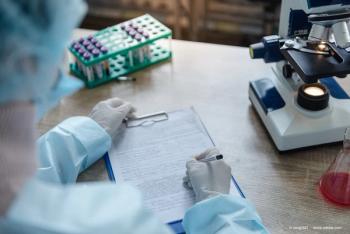
- Modern Retina Spring 2024
- Volume 4
- Issue 1
TEASE-3 study: Positive interim data reported for Stargardt drug
Gildeuretinol halts Stargardt disease progression for up to 6 years.
Reviewed by Michael B. Gorin, MD, PhD
Alkeus Pharmaceuticals Inc recently announced the interim results of TEASE-3, an open-label study designed to assess gildeuretinol (ALK-001) in early-stage Stargardt patients. It showed that treatment halted progression of early-stage Stargardt disease for up to 6 years.
Thus far, 3 teenagers enrolled in the TEASE-3 study have remained free of symptoms and progression during their treatment. One patient has remained so for 2 years and 2 patients for 6 years.
This is a groundbreaking event in that Stargardt disease, which generally begins to cause visual symptoms during childhood, but in some cases, can begin occurring in adults, is an inherited genetic mutation that until now would progress unrelentingly to vision loss and blindness because of buildup of material in the retina, according to Michael B. Gorin, MD, PhD, who said he is encouraged by the results of the different TEASE trials.
Gildeuretinol
Gildeuretinol is a novel molecule that Alkeus describes as a specialized form of deuterated vitamin A that is designed to reduce the dimerization of vitamin A without disturbing vision. In Stargardt disease, visual disruptions are caused by a mutation in the ABCA4gene, as the resulting protein facilitates the accumulation of by-products, leading to retinal damage.
In the TEASE-1 trial, gildeuretinol initially was tested in 50 patients with more advanced Stargardt disease and was found to slow the disease progression but not stop it, as in the TEASE-3 study of early-stage disease.
“This is what makes the results with early disease so dramatic,” Gorin shared. The dramatic preservation of vision in these younger patients highlights the need to consider the impact of therapies at different stages of the condition. Gildeuretinol met its prespecified primary efficacy end point with a 21% reduction in the growth rate of retinal atrophic lesions (P < .001; square root units, 28% effect for untransformed areas) against untreated patients. However, he noted, the participants in the TEASE-3 group had a much more impressive preservation of their retinal appearance and function.
TEASE-2 trial is an ongoing, fully-enrolled, randomized, triple-masked, placebo-controlled trial that enrolled 80 patients with Stargardt disease. According to Alkeus, the top-line data are expected to be released in 2025.
The company noted that TEASE-3, the first clinical trial in early-stage Stargardt disease, is an open-label study of gildeuretinol. Participants had early signs of disease visible on retinal imaging but had not begun experiencing symptoms of vision loss. The patients underwent fundus autofluorescence imaging, and other outcome measures were used to assess the extent to which the drug affected disease progression. Year-over-year progression was assessed, as well as age-matched comparison to each participant’s untreated sibling with Stargardt disease and identical mutations.
The primary end point of the TEASE-3 study is a measure of progression after the first 2 years of treatment. After the initial 2-year treatment, patients can continue to receive gildeuretinol for extended periods. TEASE-3 has enrolled a 5 patients; to date they have had no signs of disease progression while on treatment.
TEASE-4 is an open-label extension study.
Gildeuretinol has received breakthrough therapy designation and orphan drug designation by the FDA.
Vision loss in Stargardt disease
The theory of vision loss in Stargardt disease lies in the mutation in the large ABCA4 gene, which encodes a molecule or protein that is considered a flippase that moves vitamin A from 1 cellular compartment to another for reprocessing and recycling, Gorin explained.
When there is a lack or insufficiency of protein activity, vitamin A accumulates in the cells and then forms a toxic product, seen as a fluorescent material on imaging. This accumulation then triggers the complement system that attacks the cells, resulting in epithelial cell and photoreceptor death and vision loss as the result of lipofuscin.
Considering this theory of visual loss, the therapies being developed are working on 4 avenues of treatment: Reduce the amount of vitamin A taken up by photoreceptors to a safer level, provide modified vitamin A as gildeuretinol does by which the vitamin A requires more energy to react to itself and does not form toxic substances, pull lipofuscin out of the cells, and/or block the activation of complement in the cells of the eye to slow the triggering of cell death. The last approach is already used in drugs to treat geographic atrophy.
Gene therapy is another approach whereby the mutated genes would be replaced or edited in the eye. Finally, investigators are developing approaches to reconstruct the outer retina and retinal pigment epithelium from induced progenitor stem cells grown from the patient but genetically corrected to have normal ABCA4 expression.
A challenging study
The TEASE-3 study was not a typical trial that enrolled affected
patients and was supported by the FDA. Gorin recounted the great deal of discussion that went into designing the study. The first 3 participants
included in the study, 2 of whom were his patients, were asymptomatic.“This was a unique situation and opportunity in which investigators were approached by a family with an older child who had been diagnosed with Stargardt disease. When the trial started, the family sought treatment for the affected child but also for a younger, unaffected child who genetically had a 1 in 4 risk of developing Stargardt disease,” he said.
He described working through discussions among the investigators and parents to address the ethical issues, specifically, is it ethical to have an asymptomatic child undergo molecular genetic testing without having a potential therapy? “We are well aware of the emotional impact on the child and parents when genetic testing robs the child of innocence with no expectation of a means to slow or halt the disease,” Gorin commented. He added, “We also considered the issue of potential survivor guilt if we offered treatment to the younger person but withheld treatment [from] their older sibling, who had already experienced vision loss.”
In response, the investigators created the small TEASE-3 study, that allowed younger, asymptomatic patients from these highly motivated families to proceed with molecular genetic testing with the expectation that they would receive gildeuretinol if they had the same mutations as those found in their older, affected siblings.
Another issue was the small number of participants and the ability to draw conclusions from the small body of data collected. Gorin explained that they had good clinical data from the siblings who were older by a few years. “We knew that within a few years the younger children would catch up in age to the point at which the older siblings were first diagnosed with Stargardt disease and had experienced measurable vision loss before receiving the medication. We would have comparative data that would be age-matched for a sibling,” he explained.
Although this is not a design approved by the FDA, in this scenario it was the investigators’ best shot because they would know that the siblings had the same genetic mutation, lived in the same environment, had the same diet, and would most likely be very similar in other ways. Clinical data from their own patients and published studies had shown that disease severity (other than visual acuity) and patterns of retinal damage were similar among siblings at comparable ages. Therefore, the investigators thought this was a reasonable strategy to study a rare disease.
The investigators knew, based on both the theory of how the drug worked and how the mutation in ABCA4 led to cell death, that it would be far better to treat patients with early disease before the cells died in order to preserve visual function, Gorin said.
More than 90% of patients have mutations in ABCA4, but as many as 12 other affected genes have been identified that can give rise to a phenotype similar to that of Stargardt disease. There are also multiple mutations that have been identified in ABCA4, which is a huge gene with 52 exons. And to further complicate the clinical picture, these mutations in ABCA4 can give rise to different clinical appearances in a cone/rod dystrophy; those patients were not included in the TEASE trials.
Michael B. Gorin, MD, PhD
E: gorin@jsei.ucla.edu
Gorin is from the Departments of Ophthalmology and Human Genetics at the David Geffen School of Medicine at the University of California, Los Angeles (UCLA), reported no financial interest in this subject matter, and is not expressing the views of UCLA.
Reference:
Alkeus Pharmaceuticals Presents Positive Interim Data Showing Gildeuretinol Halted Stargardt Disease Progression | Alkeus Pharmaceuticals Inc. Alkeuspharma.com. Published 2023. Accessed March 6, 2024. https://alkeuspharma.com/positive-interim-data-tease-3/
Articles in this issue
over 1 year ago
Clinical trials: What to keep in mindover 1 year ago
Key takeaways from the DAVIO 2 study with Rishi Singh, MDover 1 year ago
Seeing a new realityNewsletter
Keep your retina practice on the forefront—subscribe for expert analysis and emerging trends in retinal disease management.












































